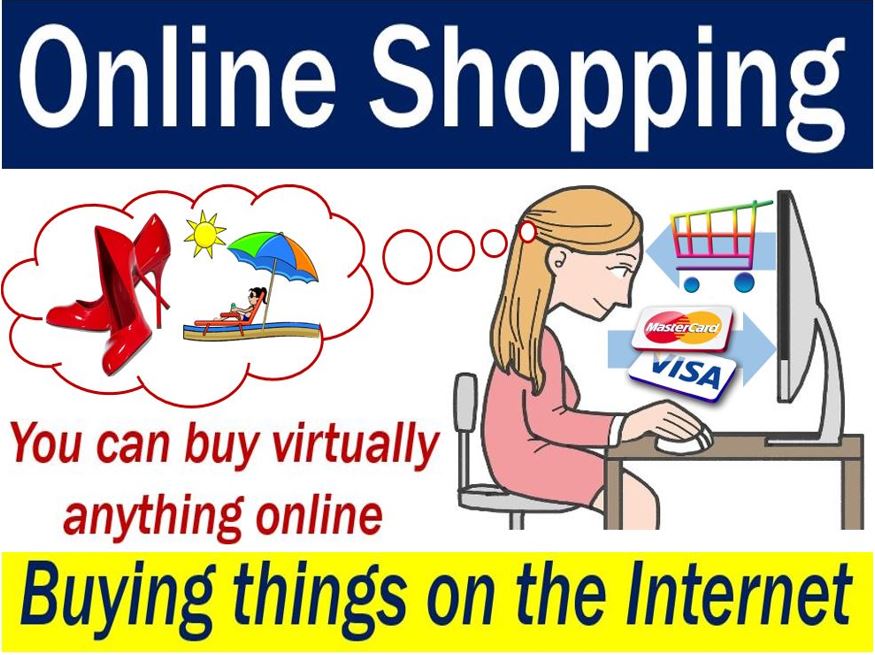Online Shopping is the activity or action of buying products or services over the Internet. It means going online, landing on a seller’s website, selecting something, and arranging for its delivery. The buyer either pays for the good or service online with a credit or debit card or upon delivery.
In this article, the term ‘online’ means ‘on the Internet.’
The term does not only include buying things online but also searching for them online. In other words, I may have been engaged in online shopping but did not buy anything.
Online shopping has been around for about twenty-five years. It has grown in popularity significantly.
Today, we can purchase nearly anything online. In fact, retail experts say that online shopping will soon overtake traditional shopping in monetary terms.
Online shopping is part of E-Commerce, which stands for Electronic Commerce.
Online Shopping occurs when a customer buys through a digital platform. Online shopping can reduce the carbon footprint associated with retail by decreasing the number of trips consumers make to physical stores.
We like buying things online
We like shopping online. The main appeal is that we can find and buy items we require without ever needing to leave the house.
Online shopping platforms often utilize data analytics to offer personalized recommendations, enhancing the consumer’s shopping experience.
During the period leading up to Christmas, online shopping is particularly appealing. It is appealing because shoppers can avoid those long lines (British: queues) with angry consumers.
Which retailers provide online shopping?
Today, most stores provide online shopping facilities. In other words, they have a website that allows consumers to purchase from them on the web.
The retailer either delivers to the shopper’s home, office, a neighbor, or a nearby store location.
Many people do their weekly supermarket grocery shopping online.
Some companies, in fact, only sell online. They have no physical shop that people can visit.
For example, Amazon sells nearly all of its goods online through its e-commerce platform.

How does online shopping work
Above all, you will need an Internet connection, a debit or credit card, and a secure password. You may also need to have an email address or mobile phone number.
Most retailers will allow you to make up your password. Make sure it is a password that nobody could guess. Avoid your birthdate and those of relatives. Ideally, you should include a combination of letters, numbers, and higher and lower cases.
You then scroll through the items the retailer is offering. Sometimes they will have a category list, such as furniture, sports equipment, gardening, etc.
Most retailers also have a search facility. This means that you can write the name of the item you seek to determine whether they have it.
Online shopping – paying
When it is time to pay, the retailer will ask for your card details. They will require the name on the card, the long 16-digit number, the expiry date, and a 3-digit number at the back. You may also need to provide details of the card’s billing address.
When giving your card details, make sure their web address starts with ‘HTTPS’ and NOT ‘HTTP.’ A web address that starts with HTTPS’ means it is a secure page, and suitable for handling payments.
Online shopping is great for buying things that are identical. For example, printer toner, toilet paper, or windshield liquid for your car are items that do not vary. However, fruit and vegetables are different. They may be overripe or not ripe enough.
Most retailers allow you to send back goods. In fact, in some countries, you get a ‘grace period.’ This means that the law allows you to send back goods within a certain period.
Therefore, online shopping is also good for items that you need to try on, such as shoes or clothes. Because you can send them back.
A ShopperTrak survey found that physical retailers face a major challenge. Their challenge is how to satisfy connected consumers. Connected consumers expect to be able to flex between physical and online stores.
When we pay for a book online or register for an e-learning course, we are paying for knowledge. In fact, knowledge commerce or K-commerce is a massive global industry.
